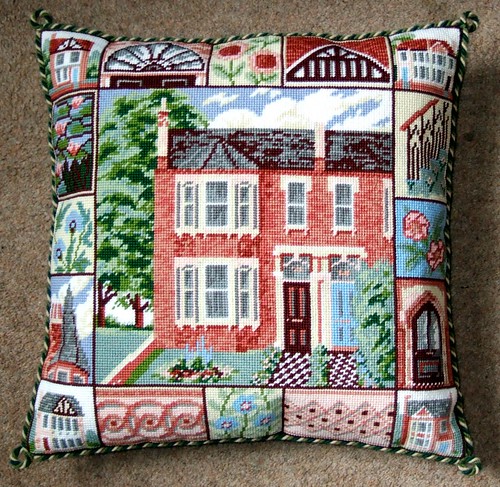Tradition says that the embroiderer must use a cotton thread in blue, white and red. And Teresa uses blue, white and red... but the shining of Viana's jewelry inspired her to use gold, too..
Tradition says that the embroiderer must use cotton and linen fabrics... but the need of modernizing her work inspired Teresa to use felt and, lately, cork fabric, too...
Tradition says that the embroiderer must use hearts, japoneiras, oak leaves and clover leaves as motifs (among others)... but lately the embroiderers have forgotten the leaves... and Teresa, inspired by her wish of being faithful to the genuineness of Viana's embroidery and her permanent desire of knowing more and more, recovered the clover and oak leaves in her stitching, too.
 |
| Blue, red and white, the most traditional colors in Viana do Castelo Embroidery. |
Teresa argues that the impressive presence of gold jewelry in her home city, Viana do Castelo, was the main influence on her choice of using metallic threads in her embroidery.
Born 100 years ago, the "modern" Embroidery of Viana do Castelo, suited for home linen, is now subject to a certification process that requires the respect of some rules which dictate the non use of golden thread. However, more than 100 years ago, the embroidery tradition was deeply rooted in this region, with a widespread use of wool yarn to embellish women's costumes: skirts, pouches and waistcoats. As you may confirm if you follow the links, this embroidery was profuse in the use of color, including metallic threads. Today these threads are not common, with the exception of their use in embroidered boxes, very popular in Viana do Castelo.
 |
| In gold, inspired by the rich jewelry. |
The choice of the clover and oak leaves as well as the use of cork are the latest innovations in Teresa's work. And the photos I bring are very recent...
In the traditional embroidery from Viana do Castelo, clovers were popular patterns. Seventy or eighty years ago there were three and four-leaf clovers and their size varied greatly, but nowadays the clovers are rare and very small. In the past, the patterns inspired by nature were stylized by the embroiderers from the Minho region. Driven by emotion, while creating a clover, the embroiderer could not resist to draw it by the joining of three or more hearts, reinventing once and again the love pattern. And that's what we find on the last embroidered heart by Artesaté, that uses this lately recovered motif and the blue from Viana's ocean.
 |
| At the top the three-leaf clover, joining three hearts |
It may sound unexpected but Teresa feels that Viana's embroidery and cork, being both famous symbols of Portugal, make a unique combination of textures and colors. It's natural that her words about the joy of embroidering on cork fabric may be overstated due to the excitement of a new love, but still they are worth being translated:
"It's a slow job that needs more attention. Stitches must be perfect at the first attempt, there is no space for errors once if you need to undo your stitching the cork fabric will be damaged. But the final work is special, more perfect, of a smoother texture to the touch and more rustic in appearance, which fits in perfectly with the tradition that I intend to transmit. The smell of cork fabric is one of the things that pleases and fascinates me the most, it spreads through the office making me feel that I'm working with nature and tradition."
 |
| In white, like tradition dictates... And recovering the oak leaf (at the top) forgotten in recent years. |
Knowing how Teresa works, I'm already curious to see where this unique combination of tradition, innovation and love for Viana will take her...
























































